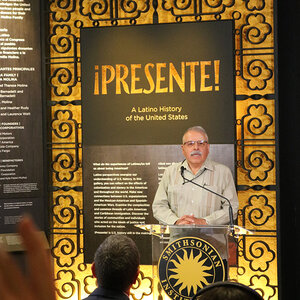Smithsonian National Museum of American History
Mission:
The Smithsonian National Museum of American History dedicates its collections and scholarship to inspiring a broader understanding of the nation and its many peoples. It creates learning opportunities, stimulates imaginations, and presents challenging ideas about the country's past.
Purpose of Site:
The NMAH Web site provides a sampler of museum programs and activities, as well as electronic access to museum resources not on view in exhibitions. It also provides information on the history of the museum, educational resources for teachers, volunteer work and internships, and research library resources. Web surfers who are planning a visit to the museum can use the site to create their itinerary and research museum events festivals, lectures, musical performances, symposia, and informal talks by curators that may coincide with their visit.
Background:
The Smithsonian Institution was established in 1846 by an act of Congress as an institution for the "increase and diffusion of knowledge." NMAH, the sixth Smithsonian building on the National Mall in Washington, D.C., opened its doors in 1964, when it was called the Museum of History and Technology. The museum's area is approximately 750,000 square feet, including a basement, three main exhibition levels, two office-collection levels, and a mechanical penthouse on the roof. The space includes workshops, laboratories, offices, libraries, and archives along with an auditorium, a bookstore, gift shops, public and staff cafeterias, an ice cream parlor, and a working post office. The museum took its current name in 1980 to better represent its basic mission the collection, care, and study of objects that reflect the experience of the American people.
Home Page:
The home page of NMAH may be simple and straightforward, but it is a portal into one of the more interesting, entertaining, and intricate sites on the Web. In addition to a link called You & the Museum, which leads to general information such as museum hours, events, and media inquiries, the page is stocked with links that would make anyone curious the Music Room, HistoryWired, and Julia Child's Kitchen, to name a few. Other links on the home page include Virtual Exhibitions, Not Just for Kids, Timeline, Star Spangled Banner, and Collections, Scholarship & Research. The page also has links to a Search Our Site tool, the museum gift store, and donation information.
Outstanding Feature:
HistoryWired can provide hours of entertainment to anyone interested in anything related to American history. Hundreds of the museum's pieces are housed in the virtual museum, with detailed information and enlarged photographs available with the click of a mouse. The main map of the virtual museum is organized into categories, with squares representing each object on display. Users can move the mouse over a square to see the name of an object, a thumbnail image of it in the blue panel on the left side of the page, and a date for the object on a timeline at the top of the page. Clicking on the square once provides users with an option to "Learn more about this object." If selected, another page will open with a large picture of the object, a detailed description, and links to related areas of interest.
Museum surfers can also customize their visits by clicking on one of the themes at the top of the page, which range from art to science, and object squares related to the selected theme will be highlighted. Users can also highlight objects from a certain time period or search the virtual collection by key word.
Honorable Mention:
The virtual exhibits, which correspond with actual exhibits at NMAH, are informative, interesting, and entertaining for children and adults alike. "The American Presidency: A Glorious Burden", for example, follows the presidency from the American Revolution through the election of George W. Bush and features profiles of all U.S. presidents and showcases objects in the museum that belonged to them. Across the top of the exhibit's Web page, a scrolling timeline is displayed with photos of the presidents. Users can move a mouse over the pictures to see the president's name and years in office and one click leads to more in-depth information.





